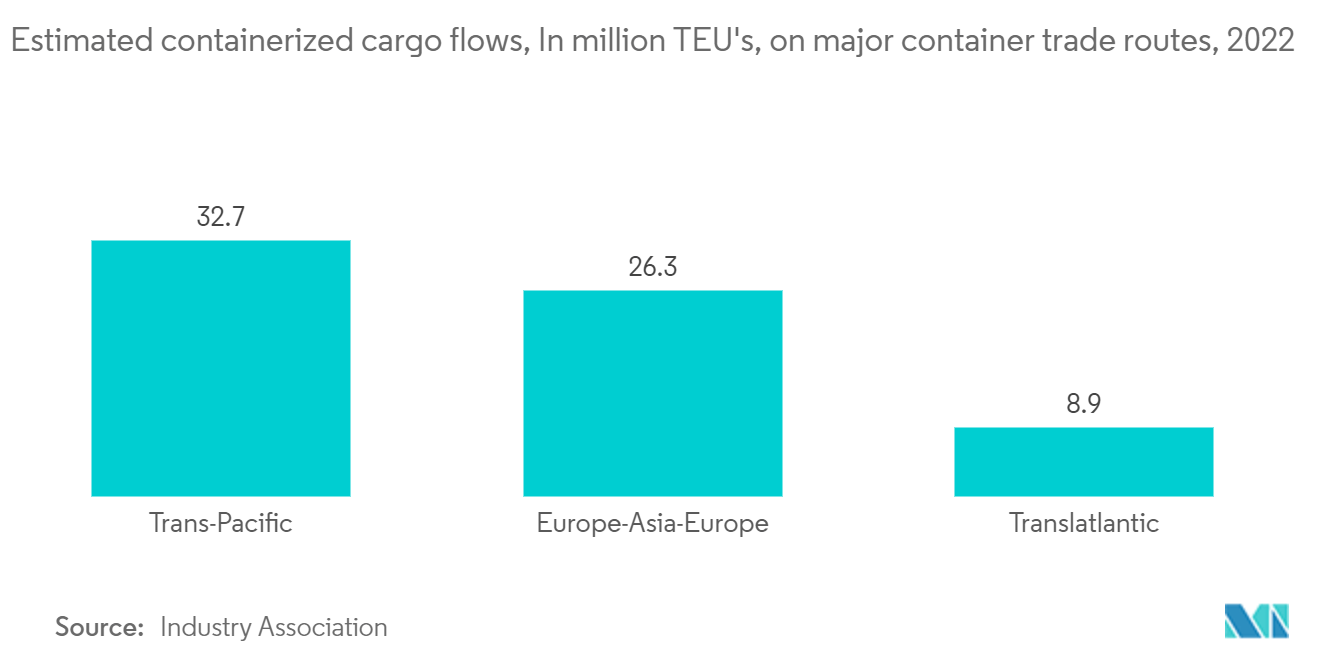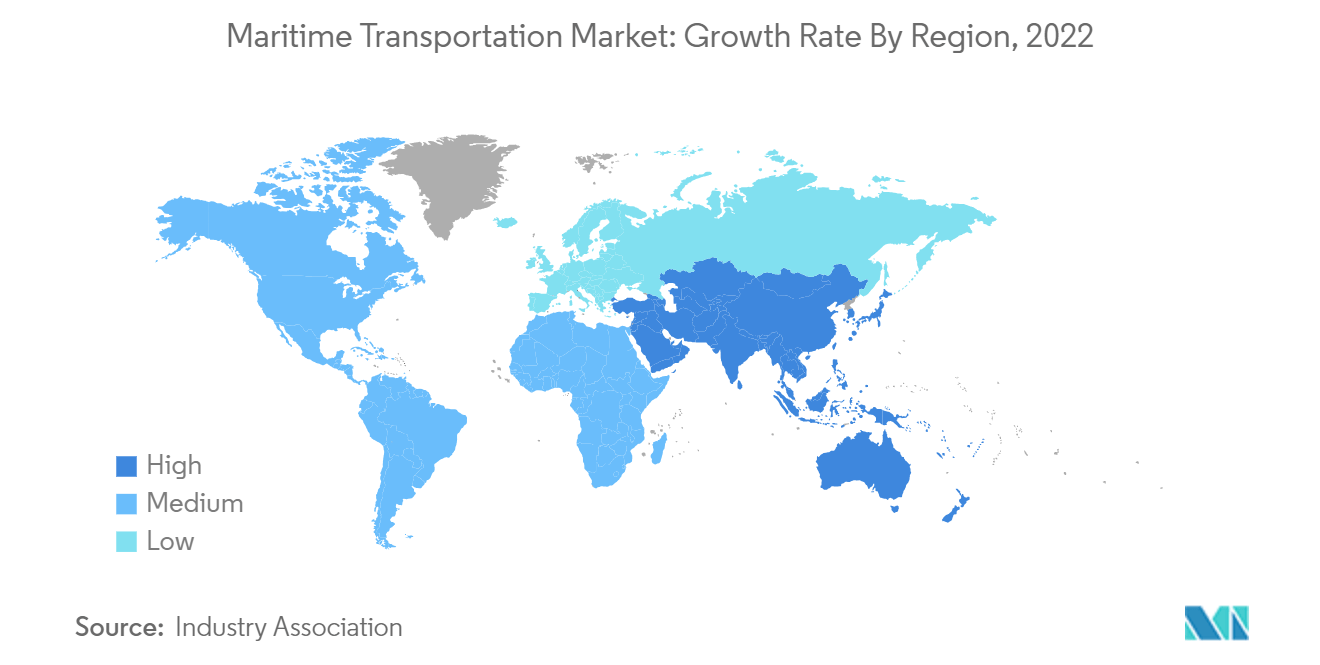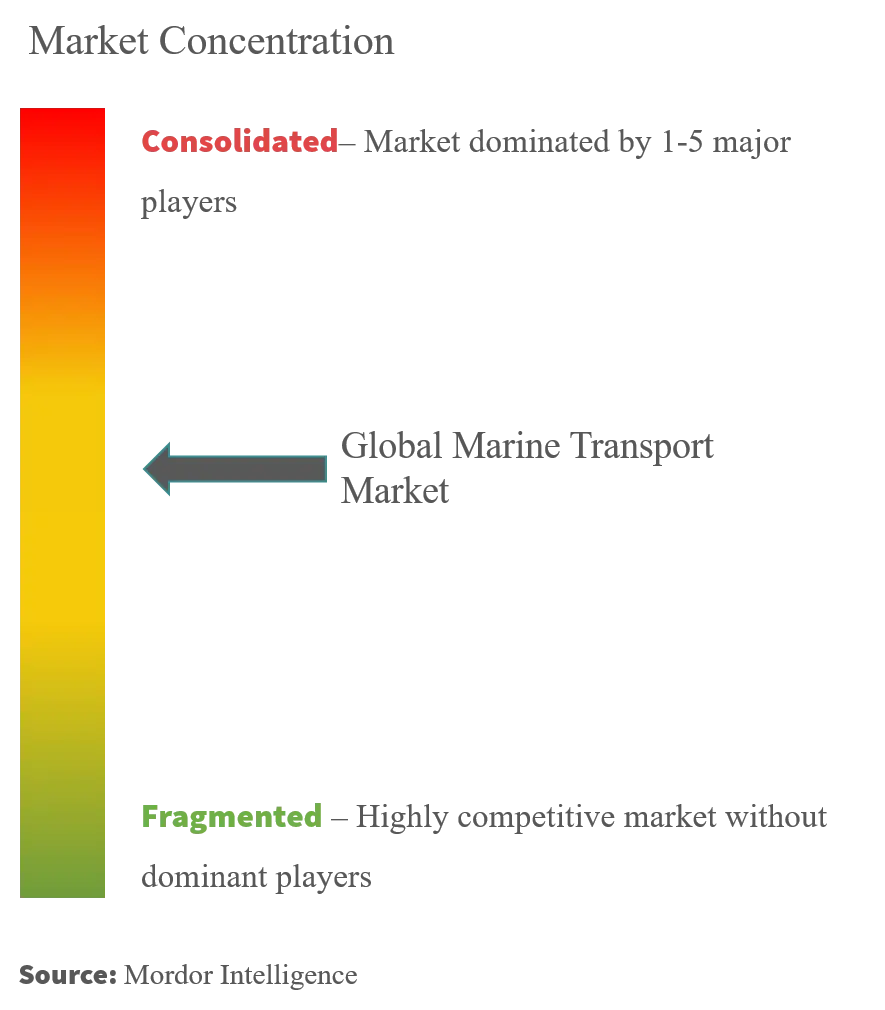Maritime Freight Transport Market Size

| Study Period | 2019 - 2029 |
| Market Size (2024) | USD 381.69 Billion |
| Market Size (2029) | USD 471.81 Billion |
| CAGR (2024 - 2029) | 4.33 % |
| Fastest Growing Market | Asia Pacific |
| Largest Market | Asia |
Major Players
*Disclaimer: Major Players sorted in no particular order |
Maritime Freight Transport Market Analysis
The Maritime Freight Transport Market size is estimated at USD 381.69 billion in 2024, and is expected to reach USD 471.81 billion by 2029, growing at a CAGR of 4.33% during the forecast period (2024-2029).
The maritime freight transport industry is responsible for the carriage of around 90% of world trade. Seaborne trade continues to expand, bringing benefits for consumers across the world through competitive freight costs. Thanks to the growing efficiency of shipping as a mode of transport and increased economic liberalization, the prospects for the industry’s further growth continue to be strong.
All the trade chains, including the major import and export trade, face a downfall. During this adverse time and the urgency of the situation, a ban had been imposed by various countries on the entry of containers and vessels that are being operated from other ports, especially those that are transported from China.
Over 50,000 merchant ships are trading internationally, transporting every kind of cargo. The world fleet is registered in over 150 nations and manned by over a million seafarers of virtually every nationality.
Concretely, it was estimated that higher grain prices and dry bulk freight rates in early 2022 contributed to a 1.2% increase in consumer food prices. Container ships spent 13.7% longer in port in 2021 compared to 2020, exacerbating delays and shortages. During the last year, total greenhouse gas emissions from the world fleet increased by 4.7%.
For many years, the fastest-growing segment was containerized trade, for which growth in 2023 is expected to reach 1.9%, according to a report titled Review of Maritime Transport by UNCTAD.
Maritime Freight Transport Market Trends
Containerization is Evolving as a Trend
According to UNCTAD (United Nations Conference on Trade and Development), international maritime trade is driven in particular by growth in containerized, dry bulk, and gas cargo. However, uncertainties like geopolitical tensions and global pandemics like COVID-19 remain an overriding theme in the current maritime transport environment, with risks tilted to the downside.
The long-term trend toward the containerization of general cargo is upward rising. A large share of globalized containerized trade continued to be carried across the major East-West containerized trade arteries, namely Asia–Europe, the Trans-Pacific, and the Transatlantic. Containerized and dry bulk trades are expected to register a compound annual growth rate of 4.5% and 3.9%, respectively, over the forecast period.
Today, over 17 million shipping containers are used worldwide, which is evolving constantly. With global trade expanding rapidly, the demand for efficient cargo transport will only grow as well.
Supply and demand have facilitated growth and change since the first standardized containers, but they’re not the only factors that have impacted how many containers are on a container ship. The size of containers over the years has affected the number as well.

Asia-Pacific is the Fastest Growing Market
The Asian-Pacific region consists of some of the fastest-growing economies in the world, like China and India. The trade exchanges support this growth in the maritime transportation sector by these countries, of which the majority of international trade takes place via sea routes.
Trends in global container port-handling activities also highlight the central role of Asia in global trade and shipping. Asian countries are experiencing a large increase in intra-regional trade, mostly based on manufacturing trades and reflecting fragmented production processes, where parts are generally manufactured in multiple locations across Asia and assembled in another location. This is also expected to increase trade, supported by marine transportation. Demand growth originated mostly in Asia, bolstered by ongoing energy policy shifts and rising export capacity in Australia and the United States.
The Asia Pacific region is characterized by the presence of some major countries that contribute substantial fleet value to the maritime freight transport market. China, Japan, Singapore, and South Korea are among the top ten ship-owning countries worldwide.
For instance, as of January 2021, China's total fleet asset value reached USD 196 billion, whereas Japan's total fleet asset value reached USD 188 billion, Singapore's total fleet asset value was USD 79 billion, and South Korea's total fleet asset value reached USD 59.6 billion.
In addition to these markets, there are several other potential developing markets for the adoption of maritime analytics, such as India, Indonesia, Vietnam, Malaysia, the Philippines, and Thailand. As per the Internal Monetary Fund (IMF), in December 2022, the top 10 sea trading countries included China, South Korea, Malaysia, and Taiwan.

Maritime Freight Transport Industry Overview
The maritime transport market is fairly concentrated, with a few players accounting for significant amounts of shares in the market. Some of the prominent companies in the market are MSC, COSCO, and AP Moller.
Maritime transport is a complex activity area, owing to the inherently international nature of shipping and its multi-stakeholder dimension. The companies in the sector currently are focusing on complying with the International Maritime Organization's lower global sulfur cap on marine fuels from January 2020 as the segment moves towards implementing the plans to reduce its carbon footprint and contribution to pollution.
Maritime Freight Transport Market Leaders
-
AP Moller (Maersk)
-
China Ocean Shipping (Group) Company (COSCO)
-
Mediterranean Shipping Company S.A. (MSC)
-
CMA-CGM
-
Hapag-Lloyd
*Disclaimer: Major Players sorted in no particular order

Maritime Freight Transport Market News
- August 2023: Apeejay Shipping Ltd (ASL) announced the acquisition of a Japanese-built vessel with a deadweight capacity of 76,812 MT. The vessel adds significant strength to the Kolkata-based company's fleet, now totaling 10 vessels and boasting a combined deadweight tonnage (dwt) of 671,332 MT.
- October 2022: Lomar Shipping, a maritime subsidiary of Libra Group, has acquired the Bremen, Germany-based Carl Büttner Holding GmbH & Co. KG. The acquisition of the 166-year-old shipowner and manager known for its technical management expertise and strong maritime legacy is Lomar's most recent step to further diversify and grow its fleet.
Maritime Freight Transport Market Report - Table of Contents
1. INTRODUCTION
- 1.1 Study Assumptions
- 1.2 Scope of the Study
2. RESEARCH METHODOLOGY
- 2.1 Analysis Methodology
- 2.2 Research Phases
3. EXECUTIVE SUMMARY
4. MARKET DYNAMICS AND INSIGHTS
- 4.1 Current Market Scenario
-
4.2 Market Dynamics
- 4.2.1 Drivers
- 4.2.1.1 Increasing global trade
- 4.2.1.2 Demand for cost-effective transportation
- 4.2.2 Restraints
- 4.2.2.1 Increasing regulations affecting the growth of the market
- 4.2.2.2 Surge in fuel costs affecting the market
- 4.2.3 Opportunities
- 4.2.3.1 Usage of new technologies boosting the market
- 4.2.3.2 Increasing demand for maritime trade across the globe
-
4.3 Industry Attractiveness - Porter's Five Forces Analysis
- 4.3.1 Threat of New Entrants
- 4.3.2 Bargaining Power of Buyers/Consumers
- 4.3.3 Bargaining Power of Suppliers
- 4.3.4 Threat of Substitute Products
- 4.3.5 Intensity of Competitive Rivalry
- 4.4 Value Chain/Supply Chain Analysis
- 4.5 Technological Advancements
- 4.6 Government Regulations and Key Initiatives
- 4.7 Insights into Transshipment Trade
- 4.8 Insights into Containerized and Non-containerized Shipments
- 4.9 Freight Rates and Maritime Transport Costs
- 4.10 Insights into Intermodal/Container Utilization
- 4.11 Demand-Supply Analysis
- 4.12 Impact of COVID-19 on the Market
5. MARKET SEGMENTATION
-
5.1 By Type
- 5.1.1 Containerized
- 5.1.1.1 General
- 5.1.1.2 Reefer
- 5.1.2 Non-containerized
-
5.2 By Geography
- 5.2.1 North America
- 5.2.1.1 United States
- 5.2.1.2 Canada
- 5.2.1.3 Rest of North America
- 5.2.2 Europe
- 5.2.2.1 Germany
- 5.2.2.2 Russia
- 5.2.2.3 France
- 5.2.2.4 United Kingdom
- 5.2.2.5 Rest of Europe
- 5.2.3 Asia-Pacific
- 5.2.3.1 China
- 5.2.3.2 Japan
- 5.2.3.3 Australia
- 5.2.3.4 India
- 5.2.3.5 Rest of Asia-Pacific
- 5.2.4 Middle East and Africa
- 5.2.4.1 Saudi Arabia
- 5.2.4.2 South Africa
- 5.2.4.3 Rest of Middle East and Africa
- 5.2.5 South America
- 5.2.5.1 Brazil
- 5.2.5.2 Colombia
- 5.2.5.3 Argentina
- 5.2.5.4 Rest of South America
6. COMPETITIVE LANDSCAPE
- 6.1 Market Concentration Overview
-
6.2 Company Profiles
- 6.2.1 AP Moller (Maersk)
- 6.2.2 Mediterranean Shipping Company SA (MSC)
- 6.2.3 CMA-CGM
- 6.2.4 China Ocean Shipping (Group) Company (COSCO)
- 6.2.5 Hapag-Lloyd
- 6.2.6 ONE - Ocean Network Express
- 6.2.7 Evergreen Line
- 6.2.8 HMM Co. Ltd
- 6.2.9 Yang Ming Marine Transport
- 6.2.10 Zim
- 6.2.11 Wan Hai Lines
- 6.2.12 PIL Pacific International Line*
- *List Not Exhaustive
7. FUTURE OF THE MARKET
8. APPENDIX
** Subject To AvailablityMaritime Freight Transport Industry Segmentation
Maritime freight transport refers to a means of transport where goods are transported via sea routes. In some cases, maritime transport can encompass pre- and post-shipping activities. The report provides a complete background analysis of the global marine freight transport market, including an assessment of the economy, a market overview, market size estimation for key segments, emerging market trends, market dynamics, and key company profiles. The report also covers the impact of COVID-19 on the sector.
The maritime freight transport market is segmented by type (containerized and non-containerized) and geography (North America, Europe, Asia-Pacific, Middle East and Africa, and South America). The report offers market size and forecasts for the maritime freight transport market in value (USD) for all the above segments.
| By Type | Containerized | General |
| Reefer | ||
| By Type | Non-containerized | |
| By Geography | North America | United States |
| Canada | ||
| Rest of North America | ||
| By Geography | Europe | Germany |
| Russia | ||
| France | ||
| United Kingdom | ||
| Rest of Europe | ||
| By Geography | Asia-Pacific | China |
| Japan | ||
| Australia | ||
| India | ||
| Rest of Asia-Pacific | ||
| By Geography | Middle East and Africa | Saudi Arabia |
| South Africa | ||
| Rest of Middle East and Africa | ||
| By Geography | South America | Brazil |
| Colombia | ||
| Argentina | ||
| Rest of South America |
Maritime Freight Transport Market Research FAQs
How big is the Maritime Freight Transport Market?
The Maritime Freight Transport Market size is expected to reach USD 381.69 billion in 2024 and grow at a CAGR of 4.33% to reach USD 471.81 billion by 2029.
What is the current Maritime Freight Transport Market size?
In 2024, the Maritime Freight Transport Market size is expected to reach USD 381.69 billion.
Who are the key players in Maritime Freight Transport Market?
AP Moller (Maersk), China Ocean Shipping (Group) Company (COSCO), Mediterranean Shipping Company S.A. (MSC), CMA-CGM and Hapag-Lloyd are the major companies operating in the Maritime Freight Transport Market.
Which is the fastest growing region in Maritime Freight Transport Market?
Asia Pacific is estimated to grow at the highest CAGR over the forecast period (2024-2029).
Which region has the biggest share in Maritime Freight Transport Market?
In 2024, the Asia accounts for the largest market share in Maritime Freight Transport Market.
What years does this Maritime Freight Transport Market cover, and what was the market size in 2023?
In 2023, the Maritime Freight Transport Market size was estimated at USD 365.85 billion. The report covers the Maritime Freight Transport Market historical market size for years: 2019, 2020, 2021, 2022 and 2023. The report also forecasts the Maritime Freight Transport Market size for years: 2024, 2025, 2026, 2027, 2028 and 2029.
What are the key segments of the Maritime Freight Transport Market?
The key segments of the Maritime Freight Transport Market are a) By Cargo Type: Container Cargo, Bulk Cargo, General Cargo, Oil & Gas b) By Industry Type: Food & Beverages, Manufacturing, Oil & Ores, Electrical & Electronics and Others
Which segment holds the largest Maritime Freight Transport Market share by Cargo Type?
Based on Cargo Type Container Cargo segment holds the largest Maritime Freight Transport Market share.
Maritime Freight Transport Industry Report
The global maritime freight transport market is essential for the movement of goods worldwide and is experiencing steady growth driven by robust international trade and advancements in operational efficiency. The market size is segmented by type into containerized and non-containerized freight, with container cargo leading due to its efficiency and versatility. The manufacturing sector heavily relies on maritime transport companies for supply chain operations, showcasing the industry's importance.
North America is a major hub in the maritime freight transport market, supported by its established trade environment and strategic port infrastructures. Europe's market continues to grow steadily, bolstered by strong trade flows and digital logistics enhancements. However, the Asia-Pacific region is projected to experience the fastest growth, driven by strong export activities and ongoing infrastructure development. Expansion in the Middle East, Africa, and Latin America reflects increased international trade and strategic advantages, further enhancing the demand for efficient maritime shipping solutions.
Industry analysis and market research indicate that market trends and market growth are positively influenced by technological advancements and the need for efficient supply chain solutions. Market leaders in the industry are continually innovating to stay ahead. The industry overview and market outlook suggest a promising future for the maritime freight transport market.
The report provides comprehensive industry information, including market data, market forecast, and market predictions. It highlights the industry size, industry sales, and industry statistics, offering a detailed market review and market segmentation. Additionally, the report includes industry reports and market value insights, which are crucial for understanding the market dynamics.
For those interested in further details, the report example and report pdf are available for download. Research companies can benefit from the in-depth analysis and industry research provided. The market overview and market segmentation sections offer valuable insights into the various aspects of the market, ensuring a thorough understanding of the market value and growth rate.
Overall, the maritime freight transport market is poised for significant growth, driven by industry trends and the need for efficient and reliable transportation solutions. The market forecast and market outlook remain positive, with market leaders continuing to drive innovation and efficiency in the industry.



